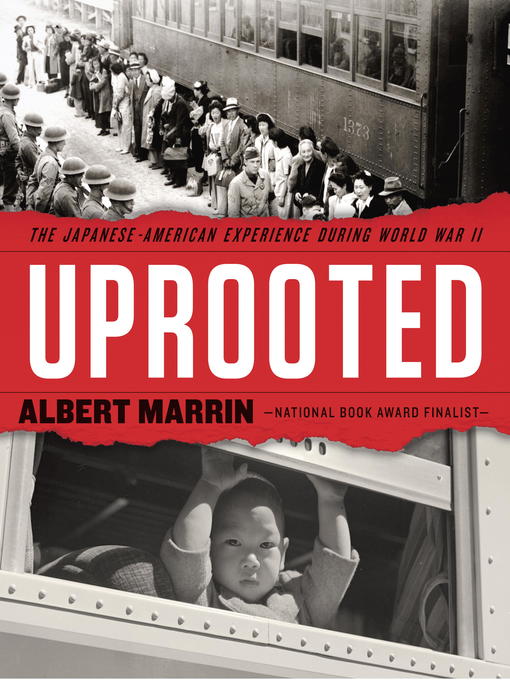
Uprooted
The Japanese American Experience During World War II
فرمت کتاب
ebook
تاریخ انتشار
2016
Lexile Score
1050
Reading Level
6-9
ATOS
8.2
Interest Level
6-12(MG+)
نویسنده
Albert Marrinشابک
9780553509380
کتاب های مرتبط
- اطلاعات
- نقد و بررسی
- دیدگاه کاربران
نقد و بررسی

Starred review from September 5, 2016
With masterful command of his subject and a clear, conversational style, Marrin (FDR and the American Crisis) lays bare the suffering inflicted upon Japanese Americans by the U.S. during WWII. Marrin delves into cultural, political, and economic strains leading up to Pearl Harbor, documenting extensive racist beliefs on both sides of the Pacific. Perceived as unacceptable security risks after the attack, Japanese immigrants living on the West Coast (issei) and their children (nisei), U.S. citizens by birth, were sent to desolate relocation centers. Only nisei trained by the military as linguists or who served in two segregated Army units in Europe were spared the humiliation of prisonlike confinement. Marrin admirably balances the heroism and loyalty of both groups with the hostile reception they received after the war and the legal battles of the few nisei who resisted; their convictions were only overturned in the 1980s. A prologue and final chapter questioning whether national security can justify the limiting of individual liberties, during wartime or as a response to terrorism, bookend this engrossing and hopeful account. Archival photos and artwork, extensive source notes, and reading suggestions are included. Ages 12–up.

"On a deeper level, the Second World War was about racism."Historian Marrin (FDR and the American Crisis, 2015, etc.) writes with brutal honesty and conviction about a shameful period in American history. He constructs a detailed, well-researched narrative of horrific worldwide events leading up to the "day of infamy." After Pearl Harbor is attacked, and wartime hysteria and fear spread, President Franklin D. Roosevelt declares war on Japan and signs into law Executive Order 9066. The order set into motion the "uprooting," or forced removal, of West Coast-based Nisei (second-generation Japanese-American citizens) and Issei (first-generation Japanese immigrants) from their homes to so-called relocation centers throughout the U.S. Woven into the narrative, personal stories and poems from the uprooted shine a sobering light on their unbearable conditions, despair, and shame. It's refreshing to see how the author calls out the War Relocation Authority's euphemisms, such as "assembly center" or "evacuation," instead telling it like it is: concentration camp and eviction. Chapters about the heroic military contributions of Nisei (while their families stayed imprisoned in camps) illustrate what it means to serve and take the high road under extremely unjust circumstances. Historical photos throughout are valuable resources that show wartime atrocities and government-censored depictions of camp life and that honor Japanese-American heroes. The author asks a chilling question: can another uprooting happen? The short answer: yes. (source notes, suggested resources) (Nonfiction. 12-18) COPYRIGHT(1) Kirkus Reviews, ALL RIGHTS RESERVED.

Starred review from October 1, 2016
Gr 7 Up-The Japanese American internment during World War II is the subject of National Book Award finalist Marrin's latest historical nonfiction for adolescents. He ties together chronological events with thematic elements (how racism operated during World War II) to tell the story of this dark time in U.S. history: "Our government failed in its duty to protect the rights of everyone living in the United States." Marrin demonstrates great attention to detail in conveying the experiences of Japanese Americans who were removed from their homes and forced to live in "relocation" centers, relying on interviews, speeches, newspaper articles, and official and personal correspondence from the time period. Of particular interest is the chapter on the Yankee Samurai, Japanese American war heroes who fought bravely for the United States while their families were denied freedom at home. Back matter includes an extensive list of suggested further reading. VERDICT Packed with details yet well organized and carefully annotated, this excellent treatment of a shameful episode in U.S. history is highly recommended for library collections serving teens.-Kelly Kingrey-Edwards, Blinn Junior College, Brenham, TX
Copyright 2016 School Library Journal, LLC Used with permission.

Starred review from August 1, 2016
Grades 9-12 *Starred Review* Between March 31 and August 7, 1942, a total of 110,000 Japanese Americans were uprooted from their homes and moved to relocation centers, which Marrinechoing thenSecretary of the Interior Harold Ickescalls concentration camps. It is Marrin's well-documented contention that this shameful act of resettlement was rooted in wartime hysteria and enduring racism, a theme that informs this masterful account. It begins with two introductory chapters that outline the history of the Pacific, focusing on Japan's role in its evolution and noting its own tradition of racism. Marrin then turns his focus to the often unhappy experience of nineteenth- and early-twentieth-century Japanese immigrants, called by newspaper entrepreneur William Randolph Hearst the yellow peril. This brings us to Pearl Harbor and an extensive account of its aftermath, culminating in the resettlement of Japanese Americans. Marrin's latest is an exceedingly rich and thorough account of the war in the Pacific and the enduring struggle for justice that culminated in 2004 with President George W. Bush's dedication of the World War II Memorial and his acknowledgment of Japanese American contributions. As with Marrin's Flesh and Blood So Cheap (2011) and FDR and the American Crisis (2015), this is a prodigiously researched, indispensable work of history, generously illustrated with period photographs. It belongs on every library's shelves.(Reprinted with permission of Booklist, copyright 2016, American Library Association.)

























دیدگاه کاربران